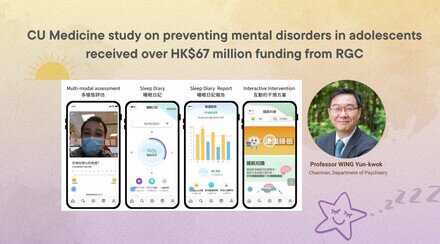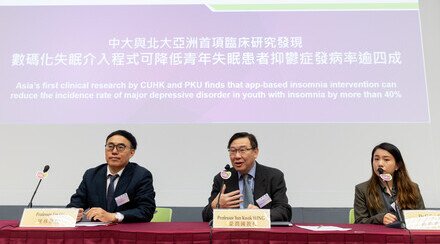CU Medicine study reveals increasing cognitive activity participation strengthens brain network
Cognitive activities are often recommended to older adults for cognitive maintenance. However, biological evidence supporting this has been scarce. A pioneering cross-disciplinary study by The Chinese University of Hong Kong’s (CUHK) Faculty of Medicine (CU Medicine) has revealed that increasing cognitive activity participation can have positive neuromodulatory effects in older adults. The researchers call for greater participation in cognitive activities as a lifestyle intervention to prevent dementia. The findings were published in the international peer-reviewed journal eBioMedicine, part of The Lancet.
Urgent need to promote brain health in older adults in Hong Kong

Professor Linda Lam cites statistics from the Hong Kong Mental Morbidity Survey for Older People, pointing out that dementia poses burdens on society and therefore it is crucial to find solutions which can help slow cognitive decline in the older population.
Dementia, a neurodegenerative disease characterised by a significant decline in cognitive functions including but not limiting to memory, attention and concentration, reasoning, and judgement, impairs people’s daily lives. Mild cognitive impairment, on the other hand, involves apparent cognitive symptoms though not severe enough to interfere with daily functioning. According to the Hong Kong Mental Morbidity Survey for Older People, one-fifth of the “young-old” (aged between 60 and 74) in the community has mild cognitive impairment, and the proportion rises to one-third for the “old-old” (aged 75 or above). More alarmingly, one in ten adults aged 70 or above in Hong Kong is living with dementia.
Professor Linda Lam Chiu-wa, from the Department of Psychiatry at CU Medicine, remarked, “Dementia poses not only a health burden on individuals but also a financial burden on families and society. Previous studies have shown that engaging in a broad range of active lifestyle activities can help slow cognitive decline in the older population. However, the mechanisms through which cognitive activity participation modulates brain functions were not fully understood and neuroimaging evidence was limited. Also, is it beneficial to participate in these activities more often?”
Positive neuromodulatory effects from increased cognitive activity exposure

Dr Keung is a Chinese calligraphy enthusiast who has been practising the art for more than 30 years. She says she did more thinking to look for practice subjects and was more disciplined in practice after being assigned to the intervention group. She encourages older adults to look for a cognitive activity that they are fond of and make it a habit, in which she believes will certainly have benefit on them.
To answer these questions, CU Medicine conducted a randomised controlled trial to investigate the effect of increasing cognitive activity participation on the default mode network (DMN) in older adults who had already been engaging in regular cognitive activity and experiencing subjective cognitive decline, a self-perceived experience of worsening cognition. Despite having normal performance on cognitive assessments and having no functional impairment, people with subjective cognitive decline are at a higher risk of progression to mild cognitive impairment and dementia. The DMN is a functionally interconnected set of different brain regions most active when people are at rest, and abnormal DMN activity is known to be associated with Alzheimer’s disease, a major type of dementia.
The research team recruited 112 community-living Chinese individuals aged 55-75 who regularly practised Chinese calligraphy for at least an hour per week, screening positively for subjective cognitive decline. They were randomly allocated to either the intervention group or the control group. The intervention group doubled their calligraphy practice time for six months, while the control group continued their usual routine. Both groups underwent Magnetic Resonance Imaging (MRI) of the brain before and after the intervention to detect changes in the functional connectivities of the DMN. The results showed that nearly all the functional connectivities within the DMN in the control group weakened, whereas those in the intervention group strengthened or showed a lesser degree of weakening. This indicates that increased cognitive activity exposure leads to positive neuromodulatory effects in older adults. The intervention group also demonstrated better working memory over time when compared to the control group.

Professor Winnie Chu says calligraphy handwriting involves visuospatial coordination, attention and non-verbal memory, which are associated with the non-dominant parietal and temporal lobes. The study has provided neuroimaging evidence which showed increasing calligraphy practice leads to stronger functional default mode network connectivity.
Professor Winnie Chu Chiu-wing from the Department of Imaging & Interventional Radiology at CU Medicine said, “Calligraphy handwriting involves visuospatial coordination, attention and non-verbal memory, which are associated with the non-dominant parietal and temporal lobes. We found that increasing calligraphy practice leads to stronger functional DMN connectivity, particularly in medial prefrontal cortex and hippocampal formation, with the temporal cortex and inferior parietal lobe. This may be due to the reorganisation and strengthening of brain networks with more practice, improving connectivity and optimising the level of activity.”

Dr Allen Lee says the study unveiled novel neuroimaging evidence that increasing exposure to regular cognitive activities, even in late life, is beneficial to brain health.
Dr Allen Lee Ting-chun, the principal investigator of the study and Associate Professor from the Department of Psychiatry at CU Medicine, said, “Our study unveiled novel neuroimaging evidence that increasing exposure to regular cognitive activities, even in late life, is beneficial to brain health. Engaging in more cognitive activities could serve as a safe and effective non-pharmacological intervention for cognitive and network maintenance in community-living older adults.”
This study, funded by the Research Grants Council of the University Grants Committee, is a testament to CU Medicine’s dedication to advancing knowledge in the field of healthy ageing and dementia prevention. CU Medicine is committed to translating scientific findings into practical applications for older adults living in the community, with the aim of improving the health of the rapidly ageing population.










































